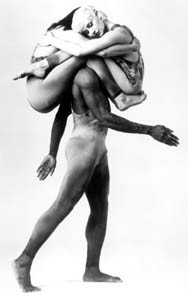Staged Heat: The dancers of Pilobolus strike a pose.
Pilobolean Logic
Dance company finds order in apparent chaos
By Marina Wolf
Even if you’ve never watched Pilobolus, you’ve probably seen Pilobolus, if only in one of those calendars or posters celebrating the dancer’s body. You can’t miss ’em, though you might not be able to count them in the tangle of arms, heads, and legs that form some of the group’s more dramatic poses.
“Yes, well, we show off a bit for those,” admits Jonathan Wolken, cofounder and one of Pilobolus’ artistic directors.
But actually the poses aren’t that much of a stretch from the dance company’s norm, as North Bay audiences will see when the group performs in San Rafael on March 16.
Onstage, the six-member company dances along an ever shifting edge between balance and glorious free fall. And Pilobolus, named after a barnyard fungus with equally vigorous habits, has become best known for works that propel the dancers along insane trajectories that intersect in the most unlikely of configurations.
To the viewer, these extraordinary meetings of bodies in time and space might seem impossible. To the dancers, claims Wolken, the positions make perfect sense.
“It’s more about balance than strength,” he says, speaking by phone from Pilobolus’ home base in Connecticut.
“You just learn how to use your weight and strength and balance in an intuitive way,” he continues, “so that when you get in a Pilobolean grapple of any sort, there is an internal logic that appears immediately.”
In another sense, this internal logic is far from immediate; it’s evolved considerably over the group’s 31 years of existence. New dancers must not only learn the repertoire–when to leap, where to catch–they also have to merge with the organic logic of the collective body.
“There is a steeping process, like tea, and you become more of Pilobolus as you do this,” Wolken says.
As Pilobolus has grown in stature in the dance world, its works have been performed by ballet companies around the country. But Wolken and the other artistic directors prefer to work with dancers who have their own movement logic.
“A really useful term is ‘movement intelligence,'” says Wolken. “It’s not really a quotient of anything, but it describes how people choose to move when they’re inventing on the spot. We want to know what they do with what they have.”
The current dancers have, among other things, experience in break dancing and martial arts, as well as traditional stints in modern companies.
In other words, they have dance training that the original Pilobolus dancers did not. The group was founded in 1971, when Wolken and other soon-to-graduate seniors took a beginning-level modern dance class at Dartmouth. The proto-Pilobolus made up for its lack of experience with a lot of excitement, strong bodies, and not a jot of technique to get in the way of creative processes.
“Technique for us was not something we were physically capable of,” recalls Wolken about those first works. “There wasn’t really much we could do that was traditional, so we began moving nontraditionally. We found ways of combining our individual bodies into an agglomerated whole of some kind or another. It wasn’t really a matter of choice. We just did what we could do.”
Then as now the group relied on improv for inspiration. You can see it when you watch them in action, in the startling rushes of their throws, leaps, and catches, in acrobatics that spring from the molten core of pure movement. At the same time, you will also notice a certain dreamlike narrative framework that has emerged with time and which Wolken considers one of the group’s more significant artistic developments.
“There are two poles–we think of them as poles in our style,” he says. “One of them is obviously abstract, and the other is very theatrical. We’ve touched on the abstract, especially in our earlier works, and the real breakthrough for us was finding a way over to the theatrical side.”
In their newest commission, a piece that debuted at the Winter Olympics last month, Pilobolus returned to its abstract origins. “The conceit of the piece was sport and art, which is of interest to us, not so much in terms of sport but the general exuberance of movement and athleticism,” Wolken says. “It taps into one of the early roots of Pilobolus, as we were more physically adept than we were artistically knowing. That has changed, of course, over 31 years, and now to go back and touch on the roots of sport and art is an interesting philosophical subject.”
The audience posed another challenge. The group was warned that the Mormon crowd would require a certain modesty, which could have been a little restrictive for a group whose physicality in pairings and groupings can be as fiery as it is fast.
“Our natural tendency when you see a man and a woman together is to take the situation sexually,” Wolken says. “That’s the direction one is pulled. That’s great, because dance works on that basis as well. There’s heat, there’s real heat. We use that sexuality and play on it.
“But at the Olympics, I think people bring a sort of chaste mind to the audience that helps us a lot.”
And if the viewers come ready to see hot stuff, that’s OK too, Wolken says. “We want the audience to bring something active with it. We don’t want a passive audience.”
Pilobolus Dance Theatre perform Saturday, March 16, at 8pm at the Marin Center, Avenue of the Flags, San Rafael. Tickets are $22-$35 for adults and $18 for kids 18 and under. For details, call 415.472.3500.
From the March 7-13, 2002 issue of the North Bay Bohemian.











